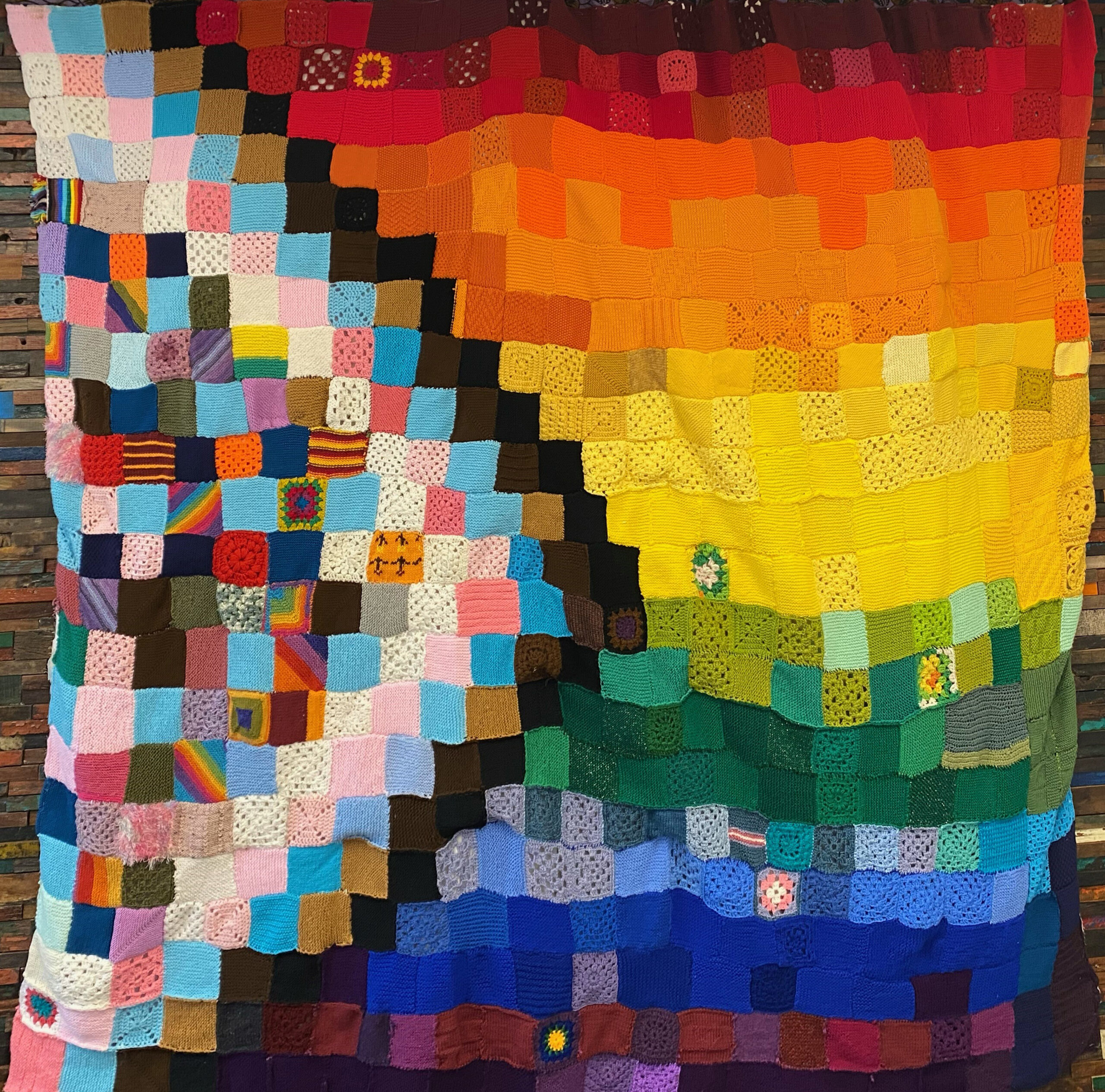Championing Inclusion at OUP: Knit for Pride

In June 2023, the Oxford University Press (OUP) LGBTIAQ+ Network embarked on an ambitious project—Knit for Pride. Colleagues worldwide picked up their needles, hooks, and looms to create 534 squares, weaving together a vibrant tapestry of Pride, diversity, and inclusion.
The tapestry was displayed in the Oxford office for a few months and continued its global tour around OUP offices. It now features at the Goldsmiths Library, University of London, as part of their LGBTQ+ Positive Voices exhibition. Next month, the tapestry will continue its tour in Asia, Australia, and Africa.
In an interview, members of the LGBTIAQ+ Network share the inspiring story behind this global project, revealing the passion, unity, and creativity that fuelled their efforts.
Q: Give us a brief overview of the OUP LGBTIAQ+ Network.
A: The Network started as a lunchtime meet-up in 2019, giving LGBTIAQ+ employees a chance to socialize during work time. The Network and Committee were created in 2020, and have since been organizing social meetups, talks and webinars, training, book and film clubs, and offering support to employees and collaborating with Group HR. We also contributed to the founding of a Cross-Publisher Collective (CPC) of LGBTIAQ+ networks that currently consists of 11 educational and academic publishers and organizes large-scale events for all member organizations. Our first hybrid CPC event was held here at OUP’s Oxford office this spring.

Q: Can you tell us about the inspiration behind the Knit for Pride initiative and how the idea came about? What was the response like?
A: As the Network is global, we knew there was an appetite for activities that would involve offices and remote workers from all over the world, and would not be dependent on time zones, or require in-person attendance. We also wanted to offer a creative and analogue activity, so members had an opportunity to meet in person in their respective offices, pass-on or learn a new skill, and see the physical result of their crafting. Our minds were blown by the response and level of engagement. Over a hundred people (from England, Scotland, Spain, US, Canada, South Africa, and Australia), took part and submitted 534 squares, which were then sewn together into a massive tapestry (measuring 3x2m/7x10ft) and weighing 5kg/8.8 pounds) in the colours of the Progress Pride Flag.
Q: Could you share some highlights or memorable moments from the project?
A: There were so many! From seeing more and more people joining in, watching photos and videos of groups of coworkers from other parts of the world meeting and crafting the squares together, to starting to receive envelopes and boxes filled with squares from other countries was so exciting. The sheer creativity in designs, stitch types and materials was a perfect demonstration of how, even though they are all different, they all fit together.
One of the highlights was definitely the tapestry being displayed in the library at Goldsmiths, University of London, as part of their LGBTQ+ Positive Voices exhibition. This topped having to sew the backing to the tapestry in a grassy field since we did not have a room large enough to do it indoors!
Q: How did the Knit for Pride initiative contribute to fostering a sense of community and inclusion within OUP?
A: What we loved about the project was how many different people came together to create the tapestry. Even though we launched it within the LGBTIAQ+ Network, many non-member colleagues joined—allies, people with a passion for crafts, and others who loved the idea. Quite a few people joined after spotting crafters creating their squares in different places around the building, and for many, this was an opportunity to learn about the meaning behind the progress flag and its importance for the LGBTIAQ+ community.
This project could not have been a success without the help of Facilities, the Business Asset Library, internal distribution colleagues worldwide, and office administrators across all the locations that took part. They were key in helping move the squares, sending the tapestry between locations, and displaying it in their buildings.
Q: In what ways has the LGBTIAQ+ Network continued to engage colleagues in initiatives promoting diversity and inclusion beyond Pride Month?
A: The Network tries to regularly organize at least one or two events each month, which range from talks and webinars, to book and film clubs, to events organized in collaboration with other OUP networks and departments (such as the BAME network, the Academic Children’s books department) or external groups (such as the CPC). Most of the events are advertised outside of the Network and are open to everyone from the organization.
Q: How do you envision the role of the LGBTIAQ+ Network evolving in the coming years, and what goals do you hope to achieve?
A: Mainly, we wish to represent all people in the community. The first step was by changing the network’s name to the more inclusive LGBTIAQ+. We are planning on doing more hybrid events to connect offices worldwide, and bring awareness to and represent diverse groups within the community in various places OUP operates, e.g. North America, India, and Australia.
Additionally, we are planning to directly support OUP’s work by contributing to content through guidelines or toolkits, and by working with different teams (e.g. publishing, product, dictionaries) to ensure that the community is represented in our products and accurately, authentically and with sensitivity.




